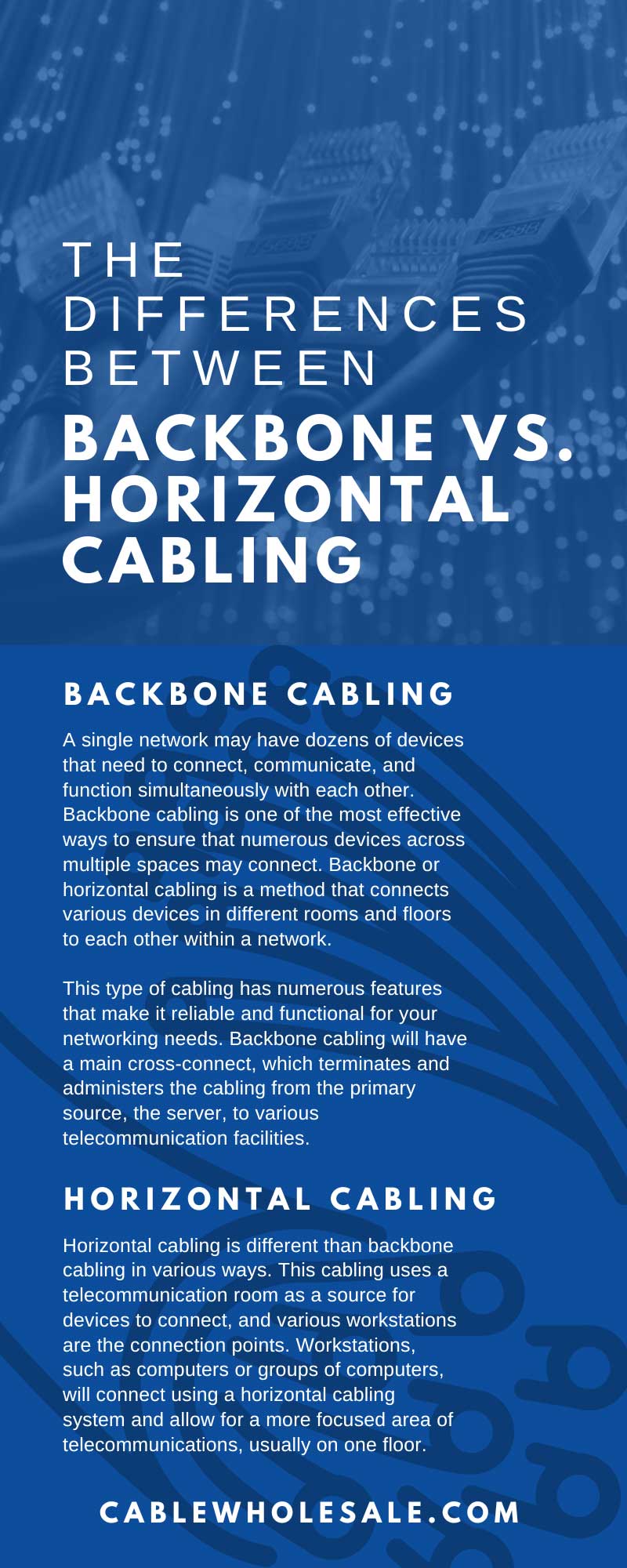
Buildings across the nation have a variety of setups to connect the devices within their network with the use of cables. Different types of cabling will allow for an effective network that carries more data at an efficient rate. Backbone and horizontal cabling are some of the most useful cabling methods for networks in various ways regarding their use and effectiveness in network structures.
Backbone Cabling
A single network may have dozens of devices that need to connect, communicate, and function simultaneously with each other. Backbone cabling is one of the most effective ways to ensure that numerous devices across multiple spaces may connect. Backbone or horizontal cabling is a method that connects various devices in different rooms and floors to each other within a network.
This type of cabling has numerous features that make it reliable and functional for your networking needs. Backbone cabling will have a main cross-connect, which terminates and administers the cabling from the primary source, the server, to various telecommunication facilities.
Application
Backbone cabling is common in office buildings or buildings with multiple locations that house networking devices. The term “backbone” comes from its connection to multiple devices on separate floors in individual rooms, similar to how someone’s backbone connects multiple nerves and organs while allowing them to function systematically.
There are two types of backbone cabling: inter-building and intra-building. Inter-building backbone cabling connects the different devices in a single building. These devices may be spread out on different floors, or they may be on the same floor but in different rooms.
Intra-building backbone cabling involves connecting devices in separate buildings, making it a long-running cable system larger than the inter-building variety. Backbone cabling will often have use for intercommunications between entrance facilities, rooms with IT equipment, and telecommunications rooms.
Installation
Installing a backbone cabling network will require numerous network cables running through various openings and pathways. For example, an Ethernet fiber optic cable may run through a shaft built into the wall that leads to different floors in the upper or lower levels.
Other network cables will work in backbone cabling, such as a coaxial or twisted pair, which can be installed in various ways so they may connect to different areas. A building may have backbone cables running behind the walls or through ceilings to reach various destinations and deliver data.
Benefits
Data communication is important in most modern businesses, and it helps to have an efficient system that allows devices to spread out and have their space. Backbone cabling will help a business function in a wide-scale operation, whether the building has numerous stories or the network is split into multiple buildings. The backbone cabling is great for long-distance cable runs, so even if you have a one-story building with numerous facilities for telecommunication, the backbone cables will connect to those as well.
Drawbacks
Although backbone cabling is typically very effective, some issues may occur within the cabling. Using various openings and pathways may become problematic when repairing or replacing a cable.
Locating the malfunctioning cable or the point at which a cable may have some damage may take time as the cables run for long lengths. Replacing old cables will also take more time as they stretch throughout the building and move through different areas, which may be challenging to access.
Horizontal Cabling
Horizontal cabling is different than backbone cabling in various ways. This cabling uses a telecommunication room as a source for devices to connect, and various workstations are the connection points. Workstations, such as computers or groups of computers, will connect using a horizontal cabling system and allow for a more focused area of telecommunications, usually on one floor.
Application
As horizontal cabling uses horizontal wiring, it will generally become limited to a single floor and the telecommunication rooms. Horizontal cabling works best for smaller buildings or smaller floors within a building. While backbone cabling may stretch throughout multiple floors and run upwards, horizontal cabling is limited to a horizontal run and will thus only work on an individual floor.
Installation
Installing horizontal cabling is different compared to backbone cabling. In order to meet TIA standards, the horizontal cables will need to have a maximum length of 90 meters between the workstation and the telecommunications room.
The cables will normally be installed into the building’s floor during construction and include copper cables such as Cat 5e or Cat 6 for fast connection speeds to multiple computers. The horizontal cabling will be in the form of a star topology, allowing each workstation a clear path to the wiring closet and reducing complications in the network and users.
Benefits
The benefits of horizontal cabling come from its direct access to the telecommunications room. The path to a room is simpler and makes it easier to find issues within this network of such a limited area. The cables underneath the floor make it easier for people to move around without worrying about tripping or safety hazards as they move between workstations.
The setup of this cabling is easier to manage. It will only take place on one floor, allowing a business to work on individual levels to improve workstations, with the horizontal and backbone cabling working well in the same network. The backbone cabling connects the entire building to the horizontal cabling of individual floors.
Drawbacks
Since horizontal cabling is limited to a single space, it may become problematic when you expand a building and require another floor above or below. The cabling may experience interference from various sources depending on where it runs through the floor, so planning may take more time and cause some headaches. You may need to pay for other devices that will allow the cables to run in an organized fashion, such as a cable manager. Also, the cost of installing horizontal cables might make initial expenses higher.
Using backbone and horizontal cabling will help create structure in a building or business. Each cabling type has various benefits, applications, and designs that make it different. By understanding these differences, it will be easier to make things more efficient within your network.




